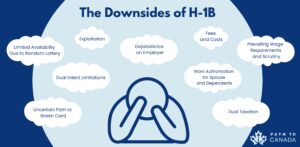Once considered the gateway to the American dream for skilled foreign workers, the H-1B visa has lost much of its appeal due to the growing downsides to H1B, including mounting challenges and complexities. In the face of ongoing tech layoffs, an increasingly convoluted immigration system, and evolving policies, many immigrants are now reconsidering the H-1B visa as a viable long-term option. While it remains a common path for highly skilled professionals to work in the United States, the uncertainties and limitations have prompted many to seek alternatives elsewhere.

H1B Visa Challenge #1: Limited Availability Due to Random Lottery
One of the most significant drawbacks of the H-1B visa is its limited availability. Each year, there is a cap on the number of H-1B visas issued – 65,000 for regular applicants and an additional 20,000 for those with advanced degrees from U.S. institutions. This cap, combined with the enormous demand for skilled labor, especially in tech industries, leads to intense competition.
In recent years, the number of H-1B applications has far exceeded the annual cap, forcing the U.S. Citizenship and Immigration Services (USCIS) to run a random lottery system to select applicants. This high-stakes process leaves many qualified candidates and their prospective employers in a state of uncertainty, not knowing if they will be selected for a visa.
For instance, during fiscal year 2022, the number of H-1B petitions approved highlighted the intense competition and the impact of the random lottery system on the selection process.
This intense competition also creates challenges for employers, particularly those in industries that rely heavily on specialized skills, such as technology, healthcare, and engineering. Employers often have to engage in costly and time-consuming sponsorship processes, only to face the disappointment of not securing a visa for their selected candidate. This situation leads some businesses to consider alternatives, including nearshoring talent to countries like Canada, where immigration pathways can be more predictable and flexible.
H1B Visa Challenge #2: Dependence on Employer for Foreign Workers
Another significant downside of the H-1B visa is the dependence it creates between the visa holder and their sponsoring employer. The visa is tied directly to the specific employer who petitioned for it, meaning that if the worker wants to change jobs, they must secure sponsorship from a new employer. This limitation can severely impact an individual’s career mobility, leaving them unable to seek better job opportunities, negotiate higher wages, or escape poor working conditions. In some cases, visa holders may stay in undesirable roles out of fear of losing their immigration status or experiencing disruptions in their work authorization during a job transition.
The employer dependency also places workers at a greater risk of exploitation. Unscrupulous employers may take advantage of the fact that H-1B workers have fewer options for switching jobs easily, pressuring them into working longer hours or accepting lower pay than their U.S. counterparts. Although H-1B workers are supposed to be paid a prevailing wage, the visa’s structure inherently limits the worker’s ability to advocate for better conditions, knowing their legal status in the U.S. is directly tied to the sponsoring employer.
H1B Visa Challenge #3: Uncertain Path to Green Card
For many H-1B holders, the ultimate goal is to secure permanent residency (a green card) in the United States. While the H-1B visa allows for “dual intent”—meaning holders can seek permanent residency while on a temporary visa—the process is often fraught with delays and uncertainty. Many visas demand a master’s degree for eligibility, but the H-1B has broader requirements, influencing job opportunities and the challenges candidates may face in finding employers who align with their level of education. Green card processing backlogs, particularly for applicants from countries like India and China, can stretch the wait for permanent residency to over a decade or more. This uncertainty adds stress to the lives of H-1B workers and their families, making long-term planning difficult.
The reliance on employer sponsorship for the green card process adds another layer of complexity. Workers must hope their employers are willing to go through the lengthy, expensive process of sponsorship, while also continuing to maintain their H-1B status, which requires regular renewals.
A change in employment during this period can further complicate the already lengthy process, forcing many to endure an extended period of uncertainty about their future in the U.S. This is particularly challenging compared to permanent residents and U.S. citizens, who do not face the same level of job market instability and visa-related stress.
H1B Visa Challenge #4: Dual Intent Limitations
The H-1B visa is a non-immigrant visa, intended for individuals seeking temporary work in the U.S. However, the “dual intent” feature allows H-1B holders to apply for permanent residency (a green card) while still holding a temporary visa. While this sounds like an advantage, the reality can be more complicated.
Pursuing permanent residency while on a non-immigrant visa can lead to complications in travel, visa renewals, and even during the adjustment of status process. For example, applying for a green card can signal an intent to stay in the U.S. permanently, which could conflict with the “temporary” nature of the H-1B visa and cause issues during visa stamping at U.S. consulates abroad or during border crossings.
Additionally, H-1B holders applying for permanent residency may face extra scrutiny from immigration officials when attempting to renew their visas or travel internationally. The dual intent policy can sometimes cause confusion among consulate officers, leading to delays or denials of travel visas. This situation can be especially challenging for workers who need to travel frequently for business or family reasons. Moreover, the path to United States citizenship for H-1B holders is often fraught with additional hurdles, making the process even more complex.
H1B Visa Challenge #5: Dependents’ Work Authorization
H-1B visa holders can bring their spouses and children under 21 to the U.S. on H-4 visas. However, work authorization for these dependents is limited. While some H-4 visa holders are eligible to apply for work authorization under specific circumstances—such as when their spouse has an approved I-140 petition for a green card—many face significant barriers to employment. This restriction can place an economic strain on families, particularly in high-cost areas like Silicon Valley or New York, where relying on a single income may not be feasible. Additionally, the inability for H-4 visa holders to work can lead to feelings of isolation and frustration, especially for those who had careers before moving to the U.S.
Many job positions filled by H-1B workers require at least a bachelor’s degree in relevant fields, highlighting the educational qualifications needed to meet labor market demands and the implications for both immigrant and native workers.
Although some progress has been made in recent years, with regulations allowing certain H-4 visa holders to apply for Employment Authorization Documents (EADs), this is still a limited group. The lack of widespread work authorization for H-4 dependents continues to be a major drawback of the H-1B visa system, affecting thousands of families.
H1B Visa Challenge #6: Prevailing Wage Requirements and Scrutiny
The U.S. Department of Labor requires employers hiring H-1B workers to pay them at least the prevailing wage for their occupation in the geographic area where they will be employed. This rule is intended to prevent employers from undercutting U.S. workers by hiring foreign labor at lower wages. While this protection is essential for maintaining fair labor standards, it can also lead to heightened scrutiny of H-1B employers. Businesses must go through detailed wage reporting, and any discrepancies can result in investigations, fines, or denials of future visa applications.
In recent years, there has been increased political attention on the H-1B program, with accusations that it displaces U.S. workers in favor of cheaper foreign labor. This increased scrutiny has led to more rigorous audits and compliance checks for H-1B employers, making the process of hiring foreign talent more cumbersome and risky for companies. Many employers now hesitate to hire H-1B workers due to fears of potential legal challenges, further reducing opportunities for foreign nationals to secure employment through this visa.
H1B Visa Challenge #7: Political and Policy Changes
The H-1B visa program is inherently vulnerable to political and policy shifts. Changes in administration can bring significant alterations to immigration policies, affecting everything from visa availability to processing times and eligibility criteria. For example, recent years have seen fluctuating policies regarding H-1B eligibility, processing times, and enforcement of wage requirements.
Certain applicants, including those from government research organizations, can circumvent the visa cap, which allows employers in specific sectors to bring in foreign workers without the restrictions faced by other applicants. Uncertainty surrounding potential changes can make both employers and visa holders uneasy, as they may have to adjust their plans according to new regulations or even sudden executive orders.
This unpredictability forces both companies and visa holders to stay informed and agile, often relying on legal counsel to navigate the constantly evolving immigration landscape. For immigrants, the stress of these potential changes can be exhausting, as even minor shifts in policy can dramatically impact their job security, immigration status, or pathway to permanent residency.
H1B Visa Challenge #8: Dual Taxation
Another downside for H-1B visa holders is the potential for dual taxation. Depending on tax treaties between the U.S. and the individual’s home country, H-1B workers may face the challenge of paying taxes in both countries. Navigating international tax laws can be complex, requiring specialized tax advice to avoid penalties or overpayment.
The costs associated with filing taxes in two countries, along with the time and effort involved, can be an additional financial burden for H-1B workers. In some cases, workers may even end up paying more in taxes than their U.S. citizen counterparts due to differences in tax policies between countries.
H1B Visa Challenge #9: Exploitation by Outsourcing Companies
The H-1B visa program has faced significant criticism for its susceptibility to exploitation by outsourcing companies. These firms, often referred to as “body shops,” specialize in bringing in large numbers of foreign workers on H-1B visas and then leasing them out to other companies. This practice has been linked to numerous issues, including wage theft, discrimination, and the overall exploitation of foreign workers.
Outsourcing companies frequently use the H-1B program to hire workers at wages lower than what would be required for American employees. This not only exerts downward pressure on industry wages but also reduces job opportunities for U.S. workers. The high turnover rate typical of these companies further exacerbates job insecurity for foreign professionals, who may find themselves in precarious employment situations.
Moreover, the operations of outsourcing firms often lack transparency and accountability. These companies may employ complex corporate structures or use shell companies to evade detection, making it challenging for government agencies to monitor and ensure compliance with H-1B visa regulations. This opacity can lead to widespread abuse of the system, undermining the program’s integrity.
To address these concerns, some experts advocate for reforms such as increasing the prevailing wage requirements and enhancing oversight of outsourcing companies. Others argue for more drastic measures, including the potential abolition of the H-1B program, citing its vulnerability to exploitation and abuse. As the debate continues, it is clear that significant changes are needed to protect both foreign workers and the U.S. labor market.
H1B Visa Challenge #10: Fees and Costs Associated with the H-1B Visa
Navigating the H-1B visa process comes with a range of fees and costs that can be substantial for both employers and foreign workers. Understanding these financial commitments is crucial for anyone considering this immigration pathway.
Firstly, there is the filing fee for an H-1B visa petition, which currently stands at $460. This fee is paid by the employer and is non-refundable, regardless of the petition’s outcome. For those seeking expedited processing, an additional premium processing fee of $1,410 guarantees a decision within 15 calendar days.
Employers often incur significant attorney fees to navigate the complexities of the H-1B visa process. These fees can range from $1,000 to $5,000 or more, depending on the case’s complexity. Additionally, recruitment fees to find qualified foreign workers can add another $1,000 to $5,000 or more to the total cost, varying by job type and location.
Foreign workers themselves may face considerable travel costs, including airfare, accommodation, and food, especially if they need to travel to the United States for interviews or to commence work. Once in the U.S., living costs such as rent, food, and transportation can be significant, particularly in high-cost cities like Silicon Valley or New York.
Overall, the fees and costs associated with the H-1B visa program can quickly add up, creating a substantial financial burden for both employers and foreign workers. It is essential for all parties to carefully consider these expenses when deciding whether to pursue an H-1B visa, as they can impact the overall feasibility and attractiveness of this immigration option.

Conclusion: Why are H-1B visa holders considering other options?
While the H-1B visa has long been a pathway for skilled foreign workers to find employment in the U.S., the various downsides to H-1B—from limited availability and employer dependency to political volatility and taxation complexities—are causing many to rethink this option. Outsourcing companies have significantly exploited the H-1B visa program, laying off tens of thousands of employees while simultaneously hiring new H-1B workers.
As the world becomes more connected, and countries like Canada, Australia, and Germany offer more streamlined immigration pathways, talented professionals may begin to look elsewhere for opportunities. While the H-1B visa still offers a valuable route for skilled workers to enter the U.S. job market, it is increasingly seen as a risky and uncertain option, prompting many immigrants to explore other, more secure paths to fulfilling their career aspirations.
If you’re considering alternatives to the H-1B visa, Path to Canada can help. We specialize in helping talented professionals explore opportunities in Canada, offering guidance on nearshoring, immigration pathways, and building your future in one of the most welcoming countries for skilled workers. Don’t hesitate to reach out to us to find your best H-1B alternative.
